Seven miles to remember the Yarnell Hill Fire, and learn the lessons from the land
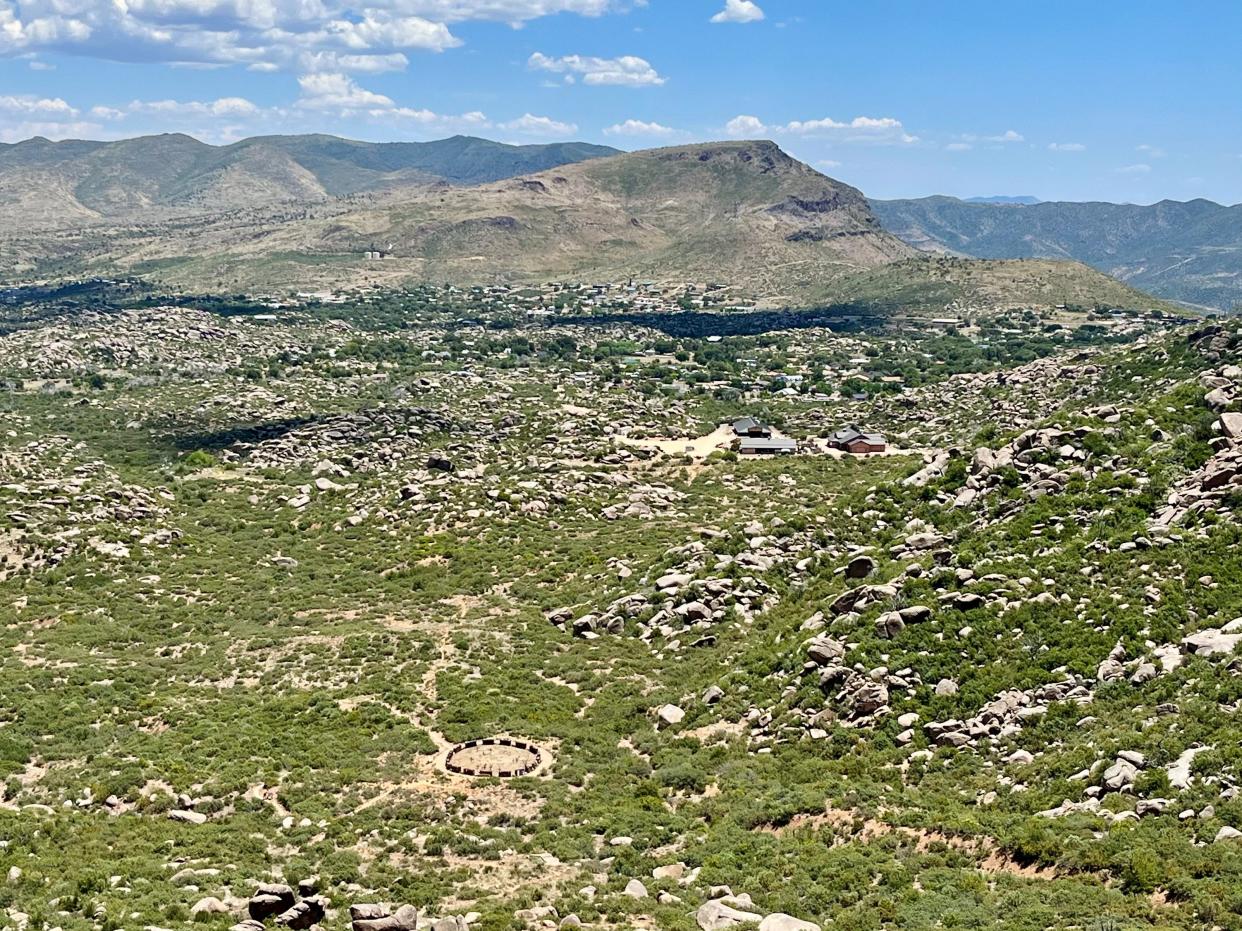
From the top of the 2.85-mile Hotshot Trail, looking down at the fatality site 500 feet below, it's heartbreaking to see how close the firefighters were to safety before being overtaken by the Yarnell Hill Fire on June 30, 2013.
Metal gabions filled with rocks — plentiful in this landscape — and chained together in final solidarity, encircle 19 metal crosses that mark the spots where members of the Prescott-based Granite Mountain Interagency Hotshots crew deployed their emergency shelters in a final act of desperation.
Their advanced skills fighting fire with fire, cutting out safety zones from the dry vegetation and persisting in infernal conditions were no match for the tall, fast flames that, pushed by a shift in thunderstorm winds, abruptly blocked their path as they traveled from one safety location to another that day.
They died less than 2,000 feet from refuge at the brush-cleared Boulder Springs Ranch in Yarnell's Glen Ilah neighborhood.
What to know: All about the Granite Mountain Hotshots and the tragic Yarnell Hill Fire
The scene, decorated with hats, patches and other items of tribute left by firefighters and community members, is a lot to take in, especially on a calm, blue-sky day when tragedy seems a distant nightmare. Opened in 2016, the Hotshot Trail, followed by the 1-mile Journey Trail down to the fatality site, gives visitors a chance to ease into the somber experience by unfolding the most deadly event for U.S. firefighters since September 11th, 2001, one memorial plaque at a time. The 7-mile round-trip trek is also a chance to reflect on how we might avoid similar outcomes in the future.
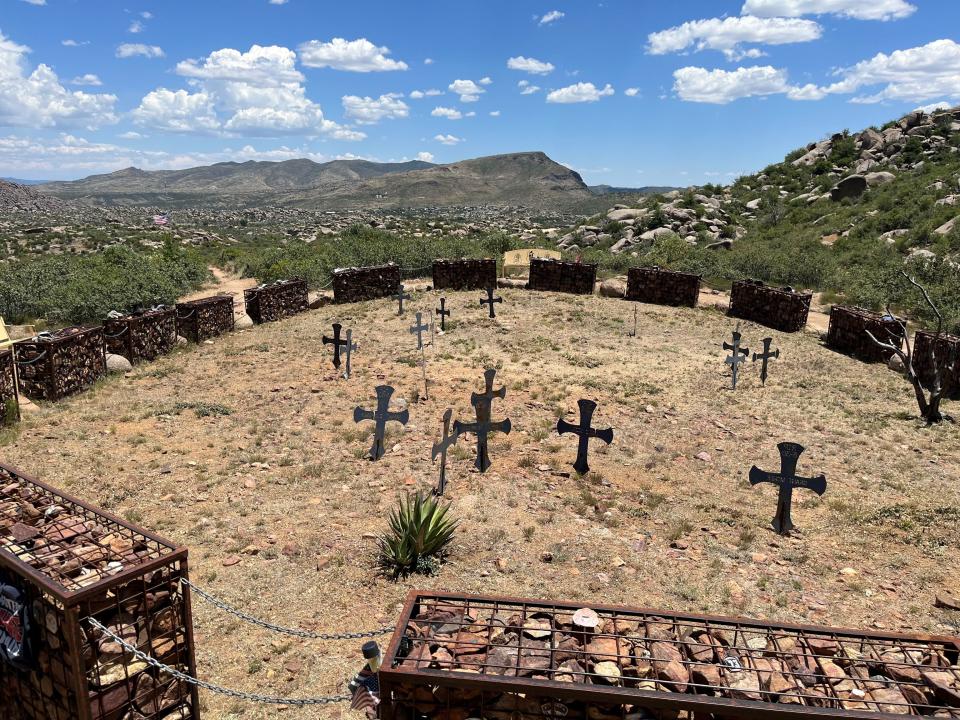
Trekking to remember
When I started the steep hike up to the fatality site, it was 84 degrees Fahrenheit, a full 16 degrees cooler than temperatures recorded nearby on the late June day 10 years ago when the Yarnell Hill Fire cut short the lives of 19 expert firefighters, ages 21 to 43.
In my t-shirt and shorts, it still felt warm, though I wasn't burdened with any of the heavy clothing or gear — chainsaws, torches, fuel — they carried.
While 2023 has been a wetter and more forgiving year for June excursions, overall trends in the western U.S. in recent decades have been toward hotter and drier conditions, linked by scientists to rising concentrations of greenhouse gases, which trap heat and energy in the atmosphere and catalyze more extreme weather patterns.
The summer of 2013 was particularly hot and dry. When lightning struck on June 28 near Yarnell, a small town southwest of Prescott with fewer than 700 residents and an unwieldy landscape of high-desert chaparral and large, gray boulders, it ignited the first blaze to befall this area in 45 years.
'Order from chaos': As wildfire behaviors change, these experts work behind the scenes
At the time, no one imagined the toll it would take. But some wildfire experts have suggested that a fossil-fuel culture combined with a build-up of dry vegetation resulting from the historic suppression of natural fires near developed areas made this and many other rural western towns vulnerable to such an event.
“When we ask why Yarnell was so overgrown with brush, that was probably attributable in some small part to our commitment to a fossil-fueled world. That energy availability changes where we build and how we organize our landscapes," said Steve Pyne, a fire history scholar and retired professor at Arizona State University. "How would we have lived before we converted so fully to fossil fuels? We would have lived off the land. We would be farming. We would be grazing. We would be clearing. We would have come into a kind of equilibrium where there was plenty of fire within a managed landscape.”
Ten years later, hiking the Hotshot and Journey Trails is one way to honor the sacrifice of the crew whose members lost their lives defending Yarnell from a blaze fueled by record drought and extreme temperatures — signatures of ongoing climate change — while contemplating how to avert future tragedy.
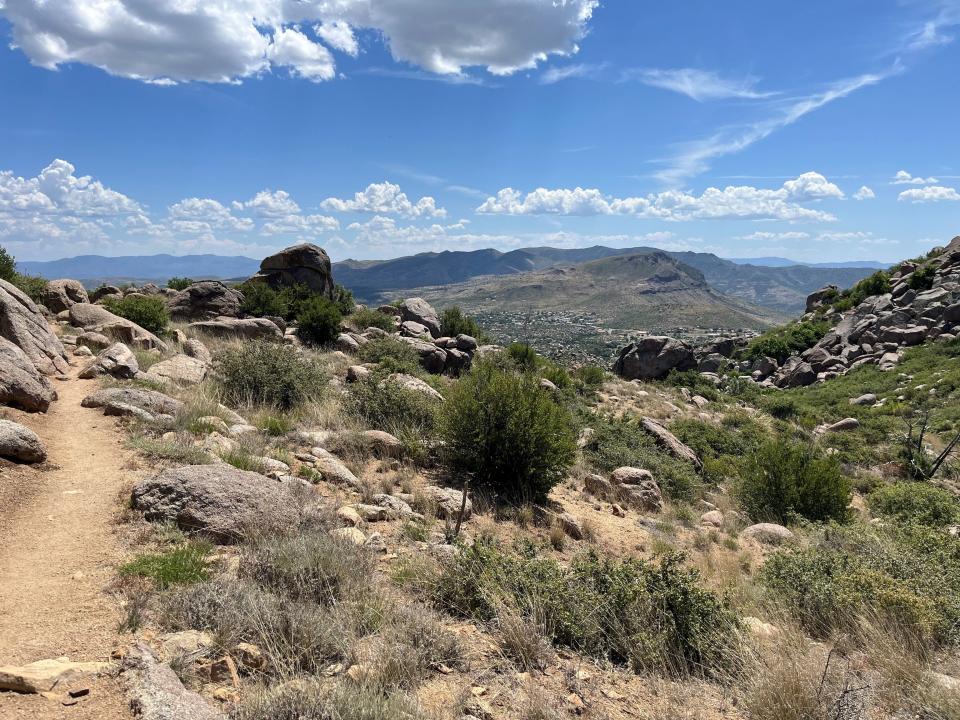
Lives lost to lifestyle choices?
From the small parking lot of the Granite Mountain Hotshots Memorial State Park, the trek is at once emotional, brutal and beautiful. Immediately, the trail tilts steeply uphill, carving out a few switchbacks before arriving at the first of 19 memorial plaques, that of crew leader Eric Marsh, who was 43, set into the stone that defines these hills.
Marsh is remembered as a loving husband, son and avid outdoorsman. He helped create the Granite Mountain Interagency Hotshot Crew and took his role as a mentor of younger wildland firefighters seriously. He died alongside his mentees when "strong and erratic winds created by thunderstorm outflow," according to an overview of the tragedy by the National Weather Service, suddenly pushed towering flames over their position.
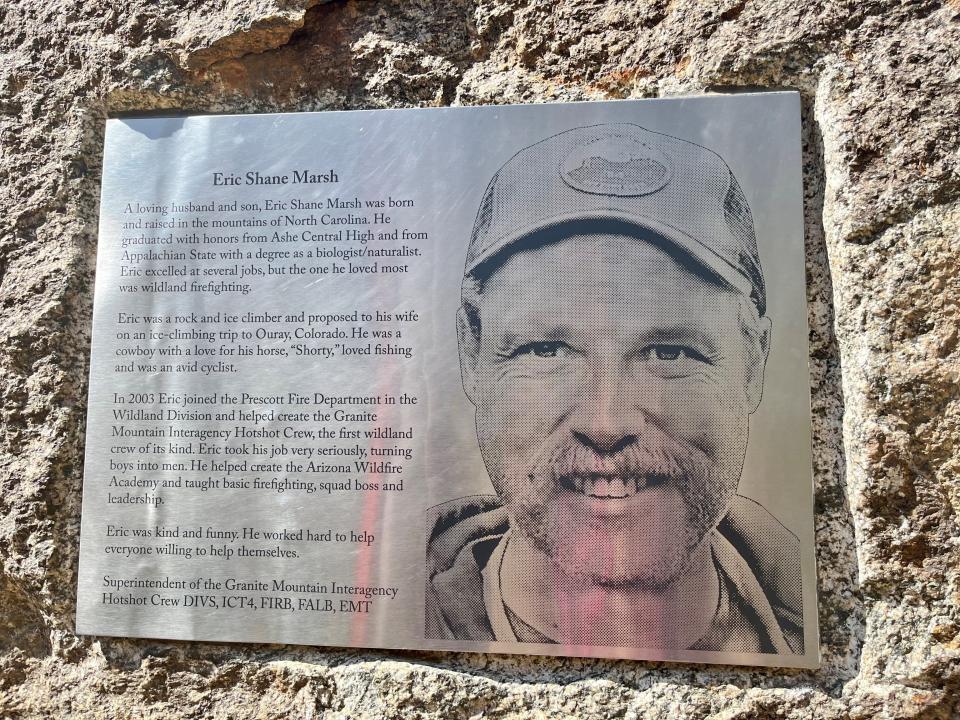
"That long, hot, dry and windy lead-in. That’s the formula for fire," said Pyne, who has written more than 30 books, mostly on the history and management of wildland and rural fire. "Arizona is pretty much the epicenter for lightning-caused fire in North America."
In light of natural challenges related to Arizona's fire-prone landscapes, Pyne says it's especially crucial to rethink how we manage vegetation now that climate change is making conditions like those leading up to the Yarnell Hill Fire more common. If we want to build homes that require protection from fire in wildlands, we should get better at learning from past successful wildfire interventions by Indigenous peoples using controlled burns and other methods, he said, and also scale back our reliance on fossil fuels to fight the conversion of forests to tinderboxes.
“The way native peoples used fire, it's like little mice nibbling their way across the landscape as opposed to now when the fires are like a stampede of buffalo or elephants," Pyne said. "We have to rethink what controlled burns mean. At the same time, if climate change continues and we continue to live the way we are, then fire on the landscape will become something different and there won’t be a restore point."
Hoping to save lives: Experts work on new air quality messaging strategies in Phoenix
What things we've built are worth defending?
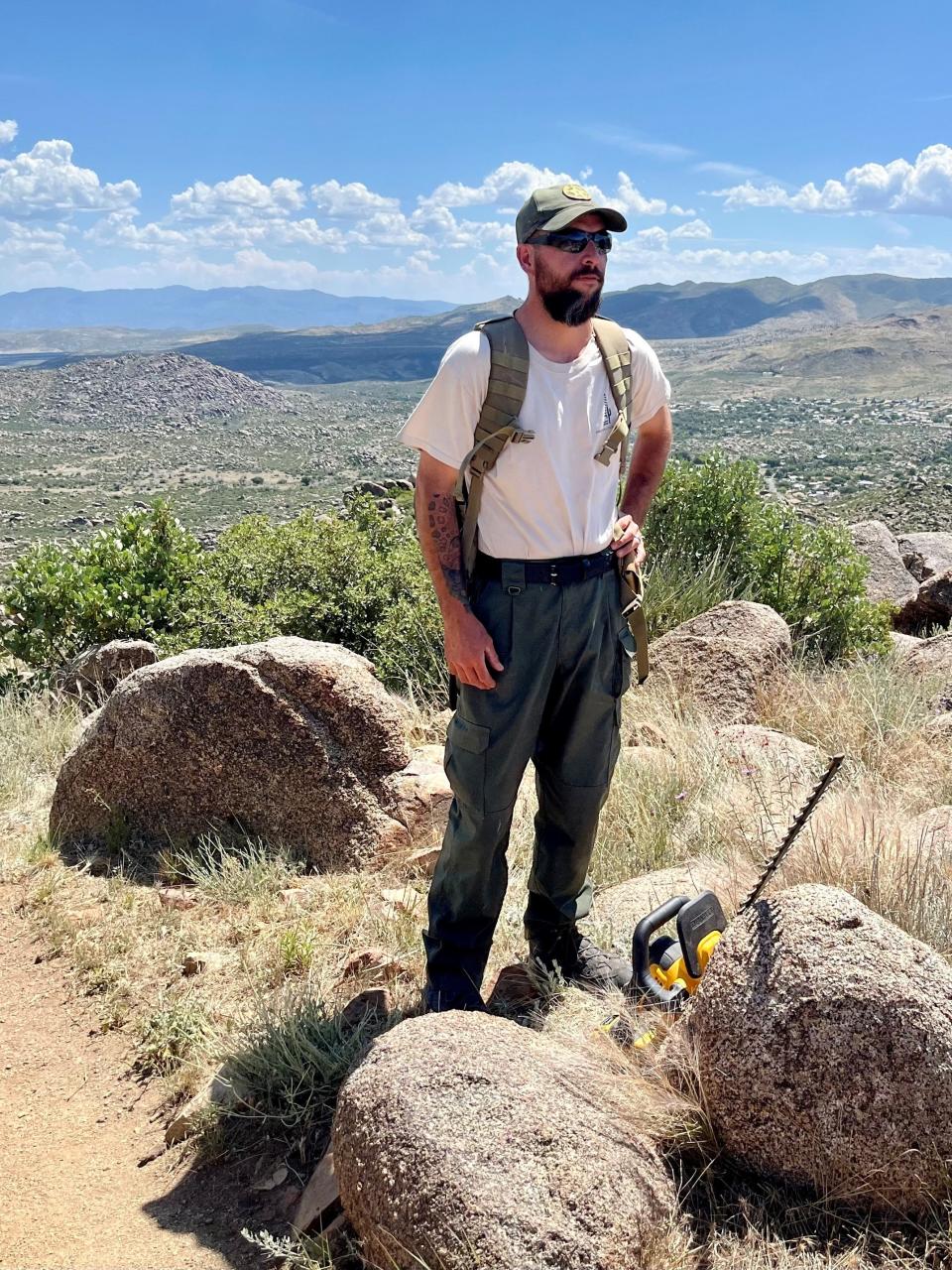
Next along the trail, the plaque for crew captain Jesse Steed, 36, remembers him as a dedicated husband and father who, after leaving the military, found brotherhood among wildland firefighters. Turning right onto another switchback, the trail continues past memorials for crew members Clayton Whitted, 28, Robert Caldwell, 23, Travis Carter, 31, Travis Turbyfill, 27, Chris MacKenzie, 30, Andrew Ashcraft, 29, and Joe Thurston, 32, before arriving at a picnic table rest spot 1.3 miles from the start.
I stopped to take a long drink from my water bottle and a long look at the unforgiving landscape. It would be hard to hurry away from approaching flames off-trail in this environment. Jagged rock covers every surface not carved out for the trail. The sun beats down on everything in sight. Wildflowers still bloom in scarce patches of mottled shade. It's quiet. Most desert wildlife is smart enough to stay in burrows during the heat of the day.
Read our climate series: The latest from Joan Meiners at azcentral, a column on climate change that publishes weekly
I continue past the markers for Wade Parker, 22, Anthony Rose, 23, Garret Zuppiger, 27, and another place to sit before reaching the plaques for Scott Norris, 28, Dustin DeFord, 24, William Warneke, 25, and one of the youngest crew members, Kevin Woyjeck, 21. I pause to read about each of these men.
After passing the plaque for John Percin, Jr., 24, I met an Arizona State Parks Ranger doing trail maintenance. He agreed to speak with me and we found a spot to sit near the plaque for the other youngest fallen hotshot crew member, Grant McKee, 21.
Jared Welsh, who grew up in Yarnell and has worked as a state parks ranger for four years, remembers the day he and his family packed up their photo albums and evacuated ahead of the Yarnell Hill Fire. The sky was eerily dark at 4 p.m. when he went to drag one of his friends out of his home and make sure he left. There was traffic on the road to get out of town, a result of most townspeople procrastinating leaving as long as possible. They hadn't seen this coming. But now, Welsh said, he understands the rising risk.
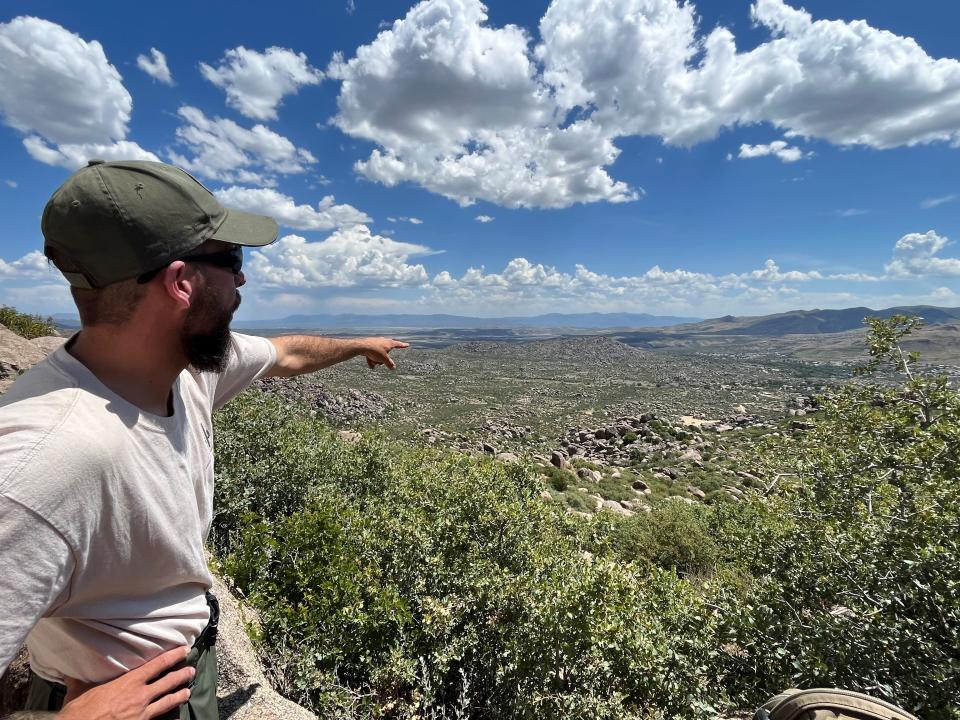
"Growing up in Yarnell, I would've never thought there'd be a big fire here. We're not in a forest," Welsh said. "But climate change is affecting the Prescott area and we're going to see that time bomb blow up. It's a multiplier and it's going to be an amplifier."
Having been mired in this tragedy for much of his adult life, Welsh is a wealth of information on what happened here. He knows the story and the landscape well, and he took the time to tell me about it as we sat beneath Grant McKee's likeness, glinting in the sun.
"When they came down this canyon, they lost all vision to the north," Welsh said, pointing out features on the landscape from the trail. "The fire was starting to move. It was starting to work its way through all these fingers here."
We spoke for over an hour. Welsh talked about bark beetle damage weakening trees in Prescott National Forest due to milder winters, about the need for climate solutions to reduce wildfire risk and about the toll COVID and low wages have taken on hotshot firefighter retention even as the need for their services increases.
He is passionate about his work maintaining this trail because he has seen what it means to people as a place to remember the victims who fought to save the town of Yarnell. At the end of our time together, he also reflected on why it's important to clear brush around structures in rural towns like Yarnell to ensure that homeowners are doing everything they can to make sure no one loses their life to save a building ever again.
"Nobody really cared about their houses, though, when we heard the hotshots had died." Welsh paused for a long moment while looking toward the Yarnell townsite. "It sucks. They never should have died for our houses."
Joan Meiners is the climate news and storytelling reporter at The Arizona Republic and azcentral.com. Before becoming a journalist, she completed a doctorate in ecology. Follow Joan on Twitter at @beecycles or email her at joan.meiners@arizonarepublic.com. Read more of her coverage at environment.azcentral.com.
Support climate coverage and local journalism by subscribing to azcentral.com at this link.
This article originally appeared on Arizona Republic: Yarnell Hill Fire tragedy still holds lessons about land management

